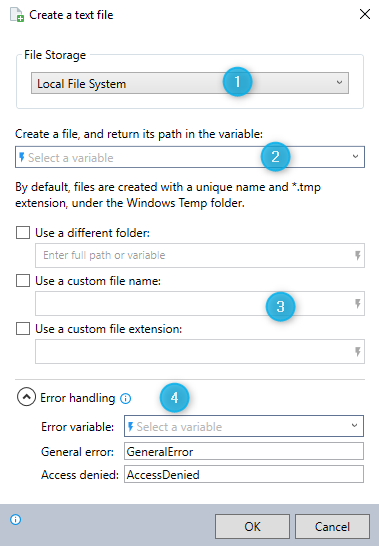Create a Text File
Create a new text file and place its file path in a new or existing variable.
This command is often used to create a file that will be later written to using the Write to Text File command.
When creating a text file, you have the option to specify the desired file storage location. You can choose to save it either in the Local File System or in SharePoint Online.

-
Select Local File System as your file storage location.
-
Enter the name of the variable where you would like to store the file path of the newly created file.
-
Indicate if the text file should be created:
-
In a folder other than the Windows Temp folder
-
Using a custom file name
-
Using a custom file extension
-
Enter the extension either in the format .xyz or simply xyz (for example,
.txtortxt). Do not include an *.
-
If you choose not to specify these options, the new file will be automatically created in the Windows Temp folder. It will have a unique file name and the file extension .tmp. -
-
Expand the Error handling option to provide instructions to the wizard on how to manage encountered errors. For more information on error handling, see Error handling.
If a file with the same name already exists in the specified location, it will be overwritten by the new file.
Don't forget to clean house!
Despite its name, Windows does not automatically delete files from the Windows Temp folder. From a safety perspective, this is great. But it does mean that your Windows Temp folder could become quite huge (and something of a resource hog) unless you manually clean it out from time to time.
You can create a file and save it directly to your SharePoint Online.
See here for details, SharePoint Online.